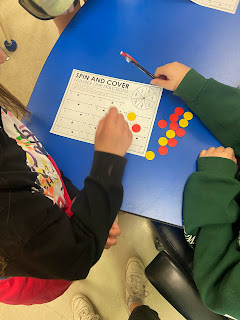Blog Post 31
May 1- 5
Learning Outcomes
Mathematics
Demonstrate an understanding of fractions by using concrete, pictorial and symbolic representations to:
- create sets of equivalent fractions
- compare fractions with like and unlike denominators
What Did Students Do?
Students were given a package of Smarties and asked to create a visual journal page to represent their understanding of fractions. They were given 10 Smarties that varied in colours, they had to determine what the fraction for each colour of smarties in their set. They then had to represent these fractions on a number line from 0 to 1 and students had to represent their fractions using a rectangle model.
Students then played a game called "Spin and Cover Number Line Fractions." They had to spin to on a spinner to get a unit fraction and mark it on the game sheet, then their partner went and did the same thing, if the fraction was already taken, players lost their turn. Once all the of the number lines were taken, the player with the most covered won!
Ask Your Child:
- What is a fraction?
- What is the top number of a fraction called?
- What is the bottom number of a fraction called?
- What does the denominator and numerator represent?
- Show me a fraction on a number line.
- When do we use fractions in our everyday life?
Coming Up
Friday, May 5th - PD Day
Monday, May 8-12 - Trickster Begins
Thursday, May 11th - Trickster Performances for parents
5:30 - 6:30 Sampson
7:00 - 8:00 Seppala



Comments
Post a Comment